Related Research Articles
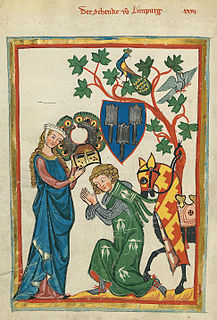
Chivalry, or the chivalric code, is an informal, varying code of conduct developed between 1170 and 1220. It was associated with the medieval Christian institution of knighthood; knights' and gentlemen's behaviours were governed by chivalrous social codes. The ideals of chivalry were popularized in medieval literature, particularly the literary cycles known as the Matter of France, relating to the legendary companions of Charlemagne and his men-at-arms, the paladins, and the Matter of Britain, informed by Geoffrey of Monmouth's Historia Regum Britanniae, written in the 1130s, which popularized the legend of King Arthur and his knights of the Round Table. All of these were taken as historically accurate until the beginnings of modern scholarship in the 19th century.
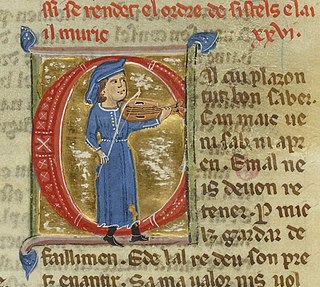
A troubadour was a composer and performer of Old Occitan lyric poetry during the High Middle Ages (1100–1350). Since the word troubadour is etymologically masculine, a female troubadour is usually called a trobairitz.
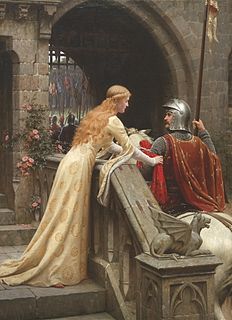
Courtly love was a medieval European literary conception of love that emphasized nobility and chivalry. Medieval literature is filled with examples of knights setting out on adventures and performing various deeds or services for ladies because of their "courtly love". This kind of love is originally a literary fiction created for the entertainment of the nobility, but as time passed, these ideas about love changed and attracted a larger audience. In the high Middle Ages, a "game of love" developed around these ideas as a set of social practices. "Loving nobly" was considered to be an enriching and improving practice.

Lyric poetry is a formal type of poetry which expresses personal emotions or feelings, typically spoken in the first person. It is not equivalent to song lyrics, though they are often in the lyric mode. The term derives from a form of Ancient Greek literature, the lyric, which was defined by its musical accompaniment, usually on a stringed instrument known as a lyre. The term owes its importance in literary theory to the division developed by Aristotle between three broad categories of poetry: lyrical, dramatic, and epic.

Romance is an emotional feeling of love for, or a strong attraction towards another person, and the courtship behaviors undertaken by an individual to express those overall feelings and resultant emotions.
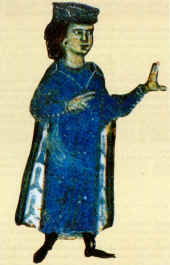
William IX, called the Troubador, was the Duke of Aquitaine and Gascony and Count of Poitou between 1086 and his death. He was also one of the leaders of the Crusade of 1101. Though his political and military achievements have a certain historical importance, he is best known as the earliest troubadour—a vernacular lyric poet in the Occitan language—whose work survived.

The Sicilian School was a small community of Sicilian and mainland Italian poets gathered around Frederick II, most of them belonging to his imperial court. Headed by Giacomo da Lentini, they produced more than three-hundred poems of courtly love between 1230 and 1266, the experiment being continued after Frederick's death by his son, Manfred.
Medieval French literature is, for the purpose of this article, Medieval literature written in Oïl languages during the period from the eleventh century to the end of the fifteenth century.

Na Castelloza was a noblewoman and trobairitz from Auvergne.
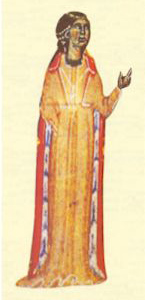
The trobairitz were Occitan female troubadours of the 12th and 13th centuries, active from around 1170 to approximately 1260. Trobairitz is both singular and plural.
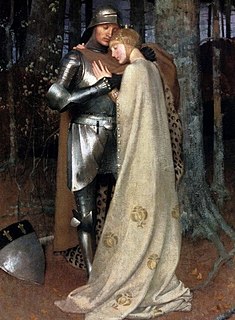
Aucassin et Nicolette is an anonymous medieval French fictional story. It is the unique example of a chantefable, literally, a "sung story", a combination of prose and verse.
Trouvère, sometimes spelled trouveur, is the Northern French form of the langue d'oc (Occitan) word trobador. It refers to poet-composers who were roughly contemporary with and influenced by the troubadours but who composed their works in the northern dialects of France. The first known trouvère was Chrétien de Troyes and the trouvères continued to flourish until about 1300. Some 2130 trouvère poems have survived; of these, at least two-thirds have melodies.

John Rykener, also known as Eleanor , was a 14th-century sex worker arrested in December 1394 for performing a sex act with a man, John Britby, in London's Cheapside while dressed as a woman. Although historians tentatively link Rykener to a prisoner of the same name, the only known facts of the sex worker's life come from an interrogation made by the mayor of London. Rykener was questioned on two offences: prostitution and sodomy. Prostitutes were not usually arrested in London during this period, while sodomy was an offence against morality rather than common law, and so pursued in ecclesiastical courts. There is no evidence that Rykener was prosecuted for either crime.

Peirol or Peiròl was an Auvergnat troubadour who wrote mostly cansos of courtly love in the late twelfth and early thirteenth centuries. Thirty-four surviving poems written in Occitan have been attributed to him; of these, seventeen have surviving melodies. He is sometimes called Peirol d'Auvergne or Peiròl d'Auvèrnha, and erroneously Pierol.

Elias de Barjols was a bourgeois Aquitainian troubadour who established himself in Provence and retired a monk. Eleven of his lyrics survive, but none of his music.
Alegret was a Gascon troubadour, one of the earliest lyric satirists in the Occitan tongue, and a contemporary of Marcabru. One sirventes and one canso survive of his poems. Nonetheless, his reputation was high enough that he found his way into the poetry of Bernart de Ventadorn and Raimbaut d'Aurenga. The work of Alegret is also intertextually and stylistically related to that of Peire d'Alvernhe.

Garin lo Brun or le Brun was an early Auvergnat troubadour.
The grand chant (courtois) or, in modern French, (grande) chanson courtoise or chanson d'amour, was a genre of Old French lyric poetry devised by the trouvères. It was adopted from the Occitan canso of the troubadours, but scholars stress that it was a distinct genre. The predominant theme of the grand chant was courtly love, but topics were more broad than in the canso, especially after the thirteenth century. The monophonic grand chant of the High Middle Ages was in many respects the predecessor of the polyphonic chanson of the Late Middle Ages.

Domnei or donnoi is an Old Provençal term meaning the attitude of chivalrous devotion of a knight to his Lady, which was mainly a non-physical and non-marital relationship.
Ruth Mazo Karras is an American historian of the Middle Ages whose interests are masculinity and sexuality in Christian and Jewish society during the Middle Ages. Her book Unmarriages: Women, Men, and Sexual Unions in the Middle Ages was named co-winner of the American Historical Association's Joan Kelly Memorial Prize in Women's History for 2012.
References
- ↑ Margaret Schaus, Women and Gender in Medieval Europe: An Encyclopedia, Taylor & Francis, 2006
- ↑ Chivalry and Love Service, in Judith M. Bennett, Ruth Mazo Karras, The Oxford Handbook of Women and Gender in Medieval Europe, Oxford University Press, 2013
- ↑ Sandra R Alfonsi, Masculine Submission in Troubadour Lyric (American University Studies), Peter Lang Publishing, 1986
- ↑ James A. Schultz, Courtly Love, the Love of Courtliness, and the History of Sexuality, University of Chicago Press, 2006
- ↑ Chivalry and Love Service, in Judith M. Bennett, Ruth Mazo Karras, The Oxford Handbook of Women and Gender in Medieval Europe, Oxford University Press, 2013
- ↑ Sandra R Alfonsi, Masculine Submission in Troubadour Lyric (American University Studies), Peter Lang Publishing, 1986
- ↑ Sandra R Alfonsi, Masculine Submission in Troubadour Lyric (American University Studies), Peter Lang Publishing, 1986